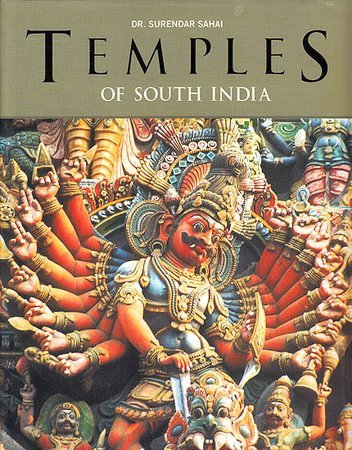Later Chola Temples
by S. R. Balasubrahmanyam | 1979 | 143,852 words
This volume of Chola Temples covers Kulottunga I to Rajendra III in the timeframe A.D. 1070-1280. The Cholas of Southern India left a remarkable stamp in the history of Indian architecture and sculpture. Besides that, the Chola dynasty was a successful ruling dynasty even conquering overseas regions....
Temples in Tiruvaigavur
Tiruvaigavur, which is in the Papanasam taluk of the Tanjavur district, is at a distance of 16 km. north-west of Kumbakonam. It is only 2.5 km. west of Vijayamangai. It is on the southern bank of the Kollidam. The god Vilva-vanesvara (or -nathesvara). has been sung by the Tamil saint Sambandar. ‘Valaikkai Nayaki’ I is the name of the Amman. The sacred tank is called Yamatirtham and the sacred tree is Vilva. According to local tradition, a hunter chased by a tiger climbed the vilva tree, and, while spending the night on the tree, plucked and dropped the vilva leaves (dear to Siva); in the morning, Siva appeared before him and blessed him. The Nandi, unlike in other temples, has his back to the deity; this is explained by local tradition as Nandi being engaged in an attempt to destroy the God of Death.
Vilvanathesvara temple
The Vilvanathesvara temple at Tiruvaigavur is an old temple dating back to the period of the Pallavas; the earliest reference to it is found in an inscription of the Pallava ruler Nandivarman dated in his 22nd year, in which the deity is called Tiruvaigavu-daiya Mahadevar. In that year, a gift of land is made for offerings and a lamp. However, this inscription is not the original one; the inscription itself mentions that it is a copy, presumably reengraved after the temple was reconsecrated in the Later Chola period. Of this we have inscriptional confirmation, in a record of the reign of Kulottunga I (who is mistakenly called a Parakesari-varman) found on the south wall of the mandapa in front of the central shrine. Dated in his 40th regnal year, it states that one Pundi Udaiyan Suriyan Pavalakkunranar alias Vannadudaiyar of Paravaichchurru-Pundi in Rajaraja valanadu petitioned to the king in his 32nd year and built of stone the central shrine and the mandapa of the temple of Tiruvaigavudaiya Mahadevar in Andattu kurram, a subdivision of Ulaguyyavandasola valanadu, after removing the old brick structure which was dilapidated. He also increased the temple devadana by augmenting it with gifts of lands in the village of Kalappakudi in Virai kurram to meet the increased requirements of the temple (ARE 51 of 1914). In the days of Kulottunga II, the temple is described as being located in Innambar nadu, a subdivision of Vadagarai Vikrama-sola valanadu (ARE 49 of 1914). Presumably Ulaguyyavanda-sola valanadu was renamed Vadagarai Vikramasola valanadu, and Innambar nadu was a part of Andattu kurram. In the 11th year of Rajaraja II, a lady-servant devaradiyal of the temple makes a gift of 30 kasus for a lamp to the temple (ARE 50 of 1914). In his 17th regnal year, an image of (presumably a shrine[1] also for) Nittavinoda-Kalyana-Sundaradevar was set up in the temple and a gift of money for offerings to the image was made (ARE 53 of 1914). In the 33rd year ofTribhuvanachakravartin Tribhuvanavira deva, ‘who, having been pleased to take Madurai, Ilam and the crowned head of the Pandya, was pleased to perform the anointment of heroes and the anointment of victors’, i.e., Kulottunga III, the temple accounts relating to the period from the 24th to the 33rd regnal years were audited by Pillai Munaiyadaraiyar who was in charge of the temple lands, when certain arrears were detected; and so a sale of land and two houses was made for recovery of revenue due on a land. Similar sales were made in respect of two other pieces of land; in one case the land was sold to the temple (shrine) of Nittavinoda Isvaram Udaiyar at Tiruvaigavur (in Innambar nadu, a subdivision of Vadagarai Vikkiramasola valanadu) (ARE 57, 58 and 60 of 1914). In Saka 1351 (a.d. 1429), in the days of Virapratapa Maharaja of Vijayan-agara, the Assembly of Parantaka nadu, a subdivision of Innambar nadu, and the ‘Valangai 98’ and the ‘98’ sects entered into an agreement regarding the payment of dues to the king (rajagaram) (ARE 59 of 1914). We have no records of any later period.
The present structure of the temple including the central shrine and the mandapa in front of it belongs to the days of Kulottunga I and should have been built between the 32nd and the 40th regnal years (i.e., a.d. 1102-1110), as vouched for by the 40th year record. The shrine for Nittavinoda-Kalyana-Sundaradeva (Isvaram Udaiyar) was brought into existence evidently in the days of Rajaraja II.
We have referred to this temple in our Early Ckola Temples (vide p. 257) when dealing with the sanctity the people and the rulers attached to places of worship and to endowments made to temples, as a result of which, when old temples were pulled down and new ones built in their place, the builders sought prior permission from the king or the regional Chief, and the earlier inscriptions were religiously transcribed into registers kept in safe custody, to be reinscribed on the walls of the new structure when complete. These are illustrated here by the copy of Nandivarman’s inscription of his 22 nd year being engraved on the walls of the newly erected mandapa, and the elaborate ritual of seeking royal permission to replace the old brick structure by a new stone structure.
Footnotes and references:
[1]:
In a later record of the days of Kulottunga III, there is a reference to a shrine for this deity.
